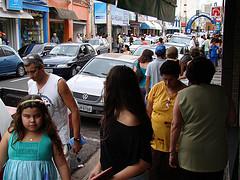In this context, our country is not of is of such transformations that intervene in incisive way with some sectors of the society. The present text, exactly in initial period of training, aims at to approach the demographic dynamics of the Microregion de Cataguases, pertaining to the Mesorregio of the Zone of Mata Minera, through one brief characterization of its population using given of the Demographic Censuses and the Population Counting of the Brazilian Institute of Geography and Statistics – IBGE. A look in microregional scale if makes necessary for the possibility of insertion in the formularization of public and also territorial politics. The Microregion de Cataguases in the Context of the Zone of Mining Mata Microregion de Cataguases is one of the seven that they form the mesorregio of the Zone of Mining Mata, that is composed for 142 cities> whose population is of 2.126.597 inhabitants – 11.03% of the population of the State of Minas Gerais (19.273.506 inhabitants) – according to data of the Population Counting of IBGE 2007.
The other microregions are: Manhuau, New Bridge, Muria, Viosa, Ub and Juiz De Fora. In the mesorregio, the city of Cataguases is as the polarizing urban nucleus, in first Juiz De Fora, polarizing the 13 cities of the microregion: Santana de Cataguases, Eusbia Owner, Orange grove Palm, Itamarati of Mines, Recreation, Leopoldina, Argirita, Pirapetinga, Antnio Saint of the Adventurer, D’ Star; White, Return Great Beyond Paraba. To understand the microregion of Cataguases, becomes necessary to lean over a little in the history of the occupation of the Mesorregio. The occupation of the Zone of Mata if gave throughout the valleys due to the relief strong wavy, leaving the topos of mount and the hillsides covered for the bush..
 Valley to stand out that in the decade of 1970 the gegrafos start to have more concerns with the social problems and to this change of mentality to give the name of renewal of geography. With the development of the industry and its impacts on the nature and society and one strong industrial politics and little public concern with the implications of this, great part of the gegrafos take left by the society and start to produce a science come back toward this thematic one, as Andrade shows to follow: Ahead of such perspectives of degradation of the conditions of life and even of possible disappearance of the humanity, the scientists in generality and the gegrafos in particular could not be of crossed arms, under the risk of connivance with the crime that is committed. If it cannot justify the construction of monumental barrages to produce and to vender energy, underneath price, the companies multinationals that contribute to deplete the available reserves, leaving in the country only the signals of the exploration, the paid wage to the workers and one few taxes. (ANDRADE, 1987, P. 117) Until the data moment the present article tells the development of Geography, its systematization and its transformation in disciplines, but little if it speaks of the responsible professional for its education, since until middle of the years 1940 they practically inexisted in Brazil.
Valley to stand out that in the decade of 1970 the gegrafos start to have more concerns with the social problems and to this change of mentality to give the name of renewal of geography. With the development of the industry and its impacts on the nature and society and one strong industrial politics and little public concern with the implications of this, great part of the gegrafos take left by the society and start to produce a science come back toward this thematic one, as Andrade shows to follow: Ahead of such perspectives of degradation of the conditions of life and even of possible disappearance of the humanity, the scientists in generality and the gegrafos in particular could not be of crossed arms, under the risk of connivance with the crime that is committed. If it cannot justify the construction of monumental barrages to produce and to vender energy, underneath price, the companies multinationals that contribute to deplete the available reserves, leaving in the country only the signals of the exploration, the paid wage to the workers and one few taxes. (ANDRADE, 1987, P. 117) Until the data moment the present article tells the development of Geography, its systematization and its transformation in disciplines, but little if it speaks of the responsible professional for its education, since until middle of the years 1940 they practically inexisted in Brazil.